Last-Minute NYC Holiday Gift Guide 🎁
We’ve created a holiday gift guide with presents for the intrepid New Yorker that should arrive just in time—

This week we’re continuing from our last installment of Don’t Forget to Look Up, where we walked from 5th Avenue at Washington Square Park to 34th Street. This section of the avenue passes through bustling midtown, and we see a complete shift from the upscale residential buildings of lower Fifth Avenue to this intensely commercial area populated by both massive department stores and chic boutiques. When you need a break from block after block of window shopping, just take a look at these buildings’ upper floors and you will be amazed by what you see.
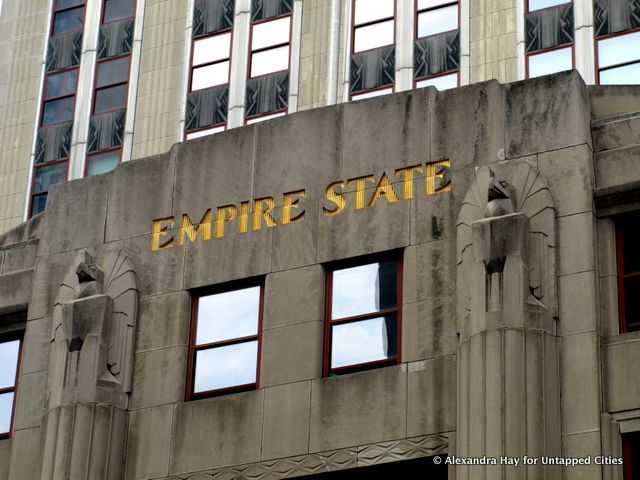
350 Fifth Avenue, the Empire State Building
The Empire State Building, from a distance, cannot be missed. However, if not for a dramatic uptick in the number of tourists milling about, you might walk right by without noticing the most iconic skyscraper in Manhattan above you. Unlike many other large buildings, the Empire State Building has no grand, open plaza to call attention to itself. Shreve, Lamb & Harmon’s 1931, 102-story skyscraper, though it looms above you at 1,472 feet tall to the top of its television antenna (and not, alas, to its dirigible mooring mast), is nonetheless understated. As architectural historian Francis Morrone puts it in The Architectural Guide to New York City, “the tower lives on the skyline, not the street.”
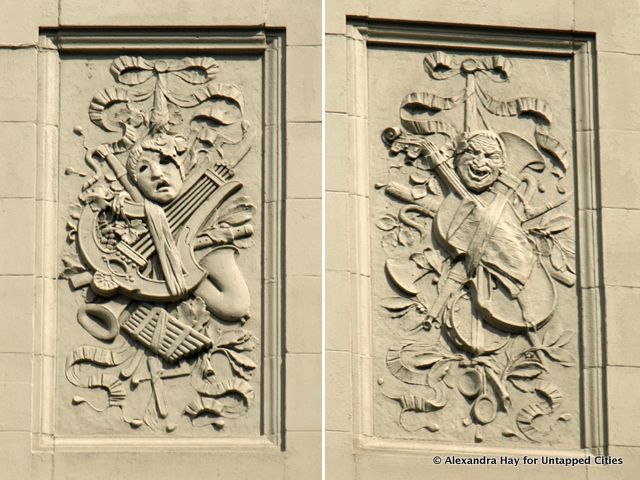
433 Fifth Avenue, former home of the Hardman Peck Piano Company
Observant passersby might guess what 433 Fifth Avenue’s former use was, based on the decorative panels up on the fifth floor. Architect Harry Allen Jacobs’ 1911 building included depictions of musical instruments and theatrical masks, appropriate images for the former home of the Hardman Peck Piano Company.
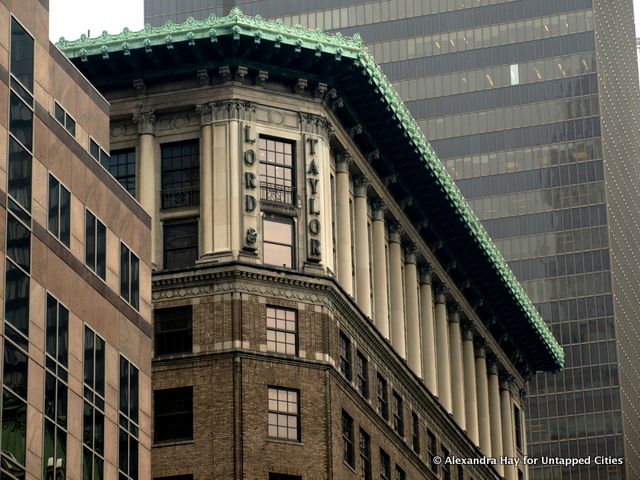
424-434 Fifth Avenue, Lord & Taylor
Starrett & Van Vleck’s design for Lord & Taylor, completed in 1914, is among the first on Fifth Avenue to actually look commercial. Rather than try to disguise it as something grander to fit in with the mansions that once dominated this area, Lord & Taylor clearly looks like a store, though it is dressed up with a chamfered corner, a grand copper cornice on top, and Italian Renaissance touches, like the 2-story limestone columns above the relatively plain brick middle floors.
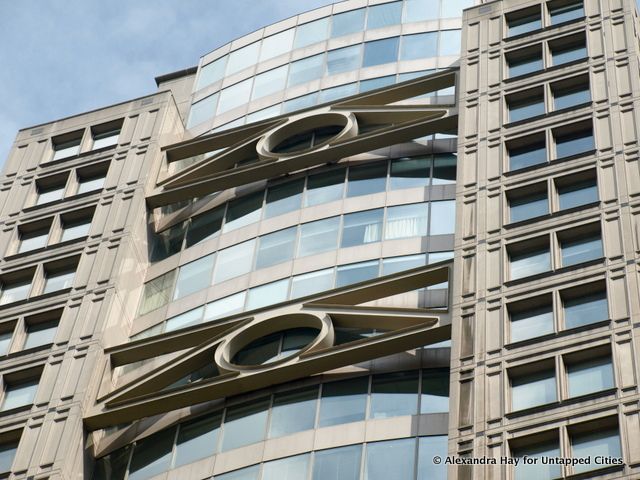
461 Fifth Avenue
Here we shift from early twentieth century grandeur to something more contemporary: Skidmore, Owings & Merrill’s 1988 skyscraper, across the street from the Beaux-Arts paragon that is the New York Public Library. 461 Fifth Avenue is a standard example of 1980s postmodernism, with exposed trusses that act as both wind bracing and decoration, and a pre-cast concrete curtain wall.
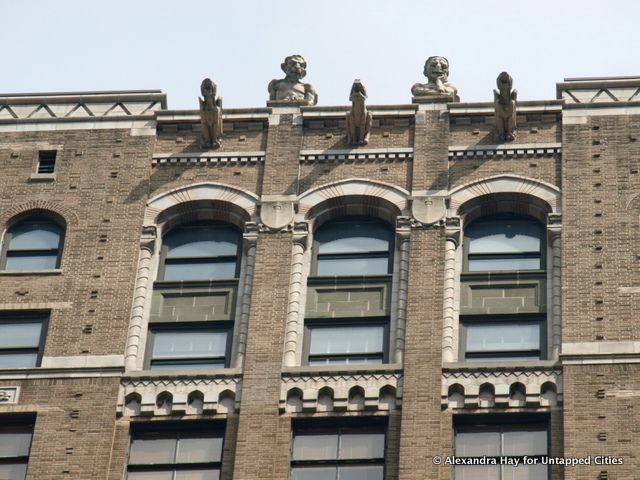
475 Fifth Avenue’s gargoyles
At the very top of 475 Fifth Avenue, built in 1926, the original gargoyles still leer down over Bryant Park, though the building’s top has otherwise been dramatically altered.
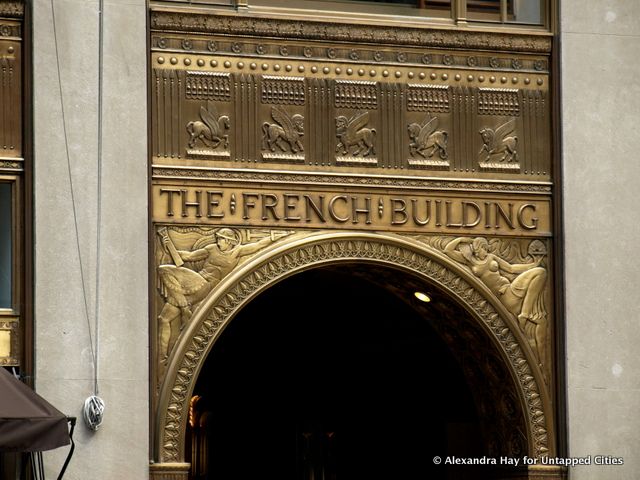
551 Fifth Avenue, the Fred F. French Building’s gilt and bronze entrance
The Fred F. French Building, completed in 1927 and designed by Sloan & Robertson, is covered from top to bottom in a blend of modern Art Deco and historical Near Eastern decorations. At the entrance, beneath the bronze frieze featuring mythological winged creatures and lotus and papyrus stalks is a gilt and bronze arch. In the arch’s spandrels: on the left, a man holding a column, T-squares, and a compass, and on the right, a woman holding a beehive, a symbol of industry that also appears on the building’s colorful top.
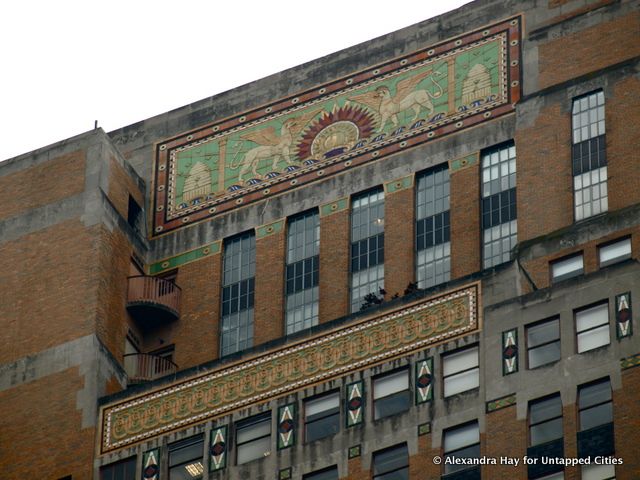
551 Fifth Avenue, the Fred F. French Building’s polychromatic top
Above the colorfully tiled upper floor setbacks, the Fred F. French Building culminates in two symbol-laden panels on the north and south sides of the building’s top. The symbolic images are meant as outward expressions of the building’s commercial use: the rising sun represents progress, and is flanked by two griffins, symbolizing integrity and watchfulness. The beehives and busy bees are symbols of industry.
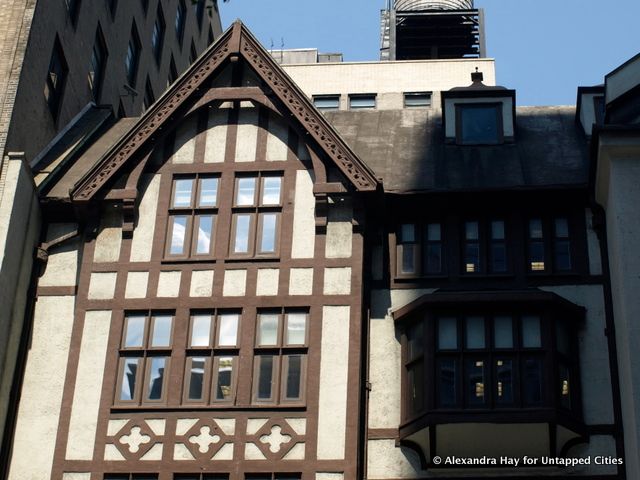
564 Fifth Avenue, an Elizabethan anomaly
Though designed in 1916, 564 Fifth Avenue is all half-timber Tudor trim and detailing. This style is scattered throughout the city, Pomander Walk a particularly unique example. This building once housed Finchley’s, a men’s clothing store, and the English architectural style evoked a respectable and comfortable old English home to put customers at ease.
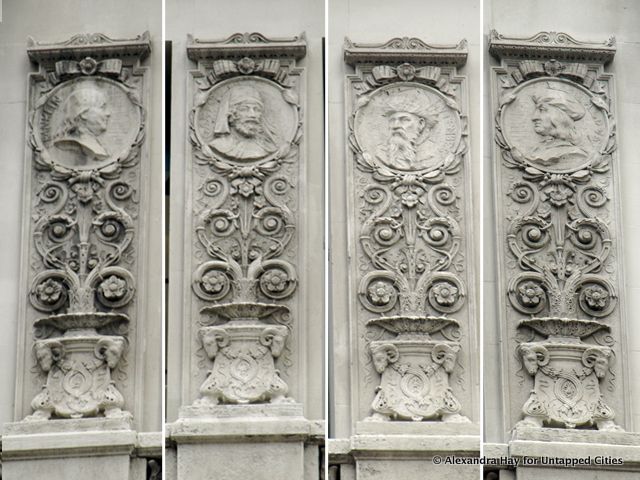
Benjamin Franklin, William Caxton, Johannes Gutenberg, and Aldus Manutius on the Charles Scribner’s Sons Building at 597 Fifth Avenue
Ernest Flagg, who also designed the now-demolished Singer Building, is the architect behind the beautiful Charles Scribner’s Sons Building. It’s beloved by bibliophiles everywhere, though it now has a Sephora on the ground floor where the Scribner bookstore used to be. Book lovers should not despair, however: if they look up, they will see on the facade the profiles of four titans of printing and publishing: Benjamin Franklin, a Founding Father, pioneer of American printing, and organizer of the country’s first circulating library; William Caxton, the first English printer and the printer of Chaucer’s Canterbury Tales; Johannes Gutenberg, inventor of the printing press; and Aldus Manutius, the great Venetian printer, publisher, typographer, and founder of the Aldine Press.
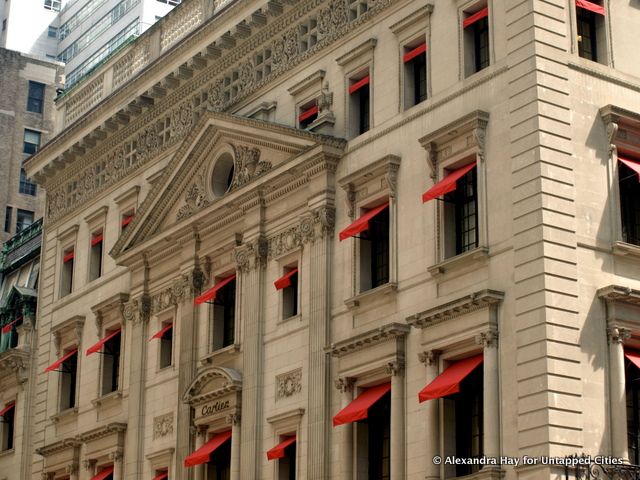
651-653 Fifth Avenue, Cartier
Constructed in 1905 and originally designed by Robert W. Gibson as a mansion for Morton Plant, son of railroad tycoon Henry Plant, the opulent building at 651-653 Fifth Avenue is now the home of Cartier. The 52nd Street facade of the building, which you can get a good view of from Fifth Avenue, was once the mansion’s main entrance, with grand Ionic pilasters and a pediment pierced by an oculus window. The frieze at the top of the building is densely covered with intricate, naturalistic details.
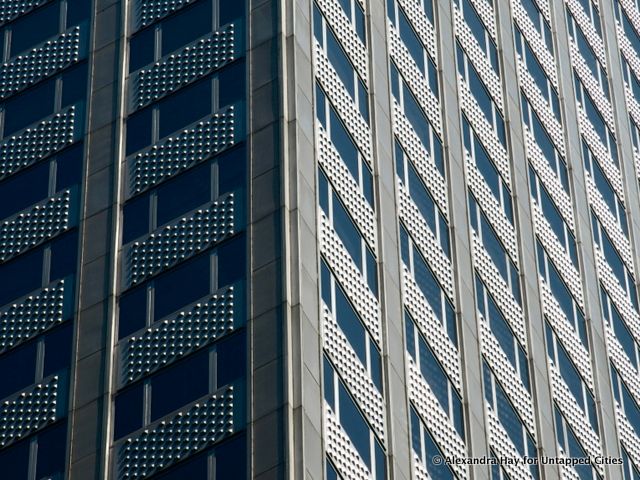
666 Fifth Avenue
The look of the embossed aluminum facade of Carson & Lundin’s 1957 office building at 666 Fifth Avenue–once the site of William K. Vanderbilt‘s “Petit Chateau”–changes dramatically with the weather, and can be almost blinding in the sun.
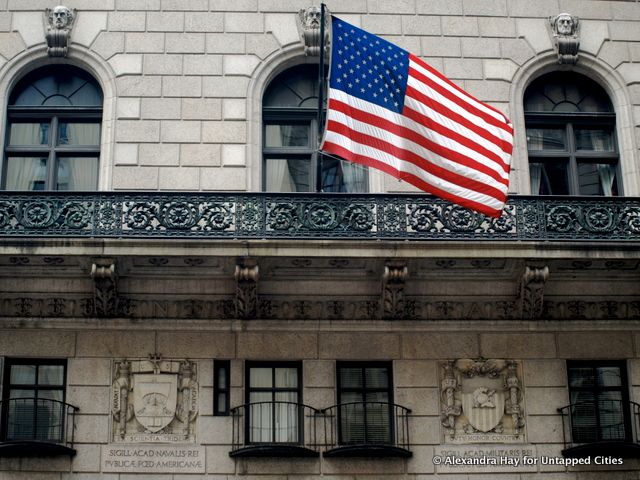
1 West 54th Street on the northwest corner of Fifth Avenue, the University Club
Despite the flag and the shields of American universities decorating the facade, the University Club looks like a relic of the Renaissance, with rusticated walls, ornate bronze balconies, and carved faces topping the arched windows. The AIA Guide to New York City vividly describes the building, designed by Charles McKim of McKim, Mead & White, as a “Florentine super-palazzo beyond the Medicis’ wildest dreams.”
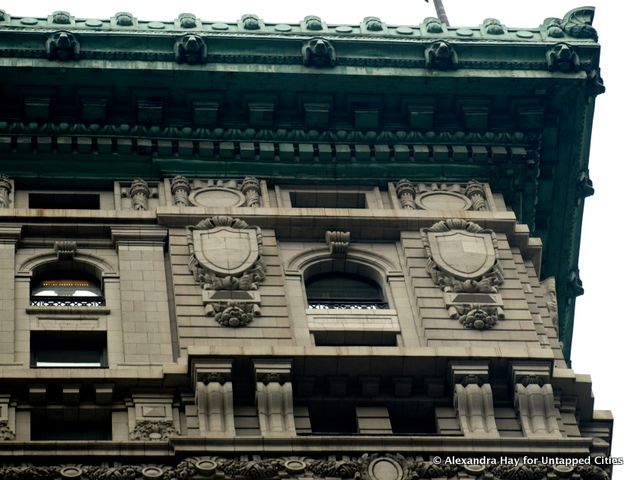
2 West 55th Street on the southwest corner of Fifth Avenue, the Peninsula Hotel
Located on the next corner, the Peninsula Hotel was designed by Hiss & Weekes, former employees of McKim, Mead & White, and their work fits right in with that of their former employers. The neo-Renaissance style of the Peninsula, with its rusticated stonework, arches, and ornament, echoes that of the University Club next to it, though the Peninsula is twice as tall and also sports an impressive cornice.
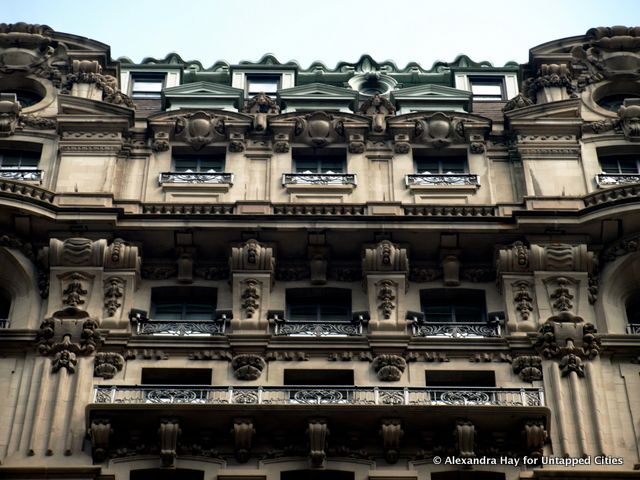
2 East 55th Street on the southeast corner of Fifth Avenue, the St. Regis Hotel
Named after a lake in the Adirondacks, which in turn was named after a French saint known for his hospitality, the St. Regis Hotel, directly across Fifth Avenue from the Peninsula, outdoes all its neighbors in over-the-top Beaux-Arts opulence. The building’s richest decoration can be found at the top, which features balconies, a mansard roof, pedimented dormer windows, oculus windows, and ornate embellishments. Even if you don’t have time to stop for a drink in the Hotel’s King Cole Bar, you might take a moment while passing by to glance up at the architectural extravagance above you.
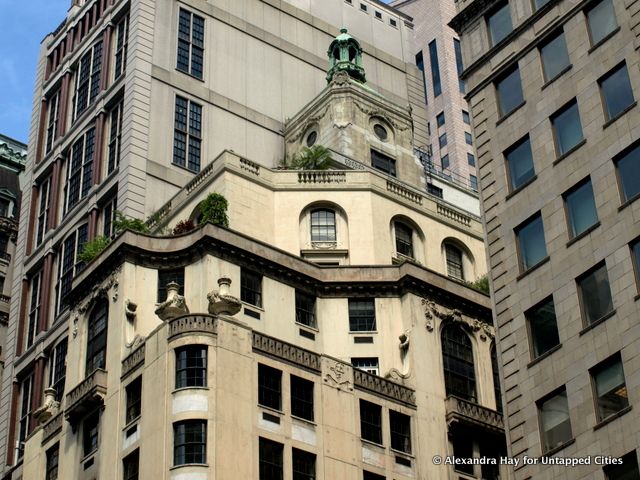
689-691 Fifth Avenue, the Elizabeth Arden Building
This graceful corner building was completed in 1927 and designed by Warren & Wetmore, the architects, with Reed & Stem, of Grand Central Terminal. Built with warm, buff-colored Indiana limestone, terra cotta, and marble panels, the Elizabeth Arden Building combines Art Deco and Renaissance details. At the very top, above the rounded corner, decorative urns, and multiple setbacks, is a patinated copper-topped lantern.
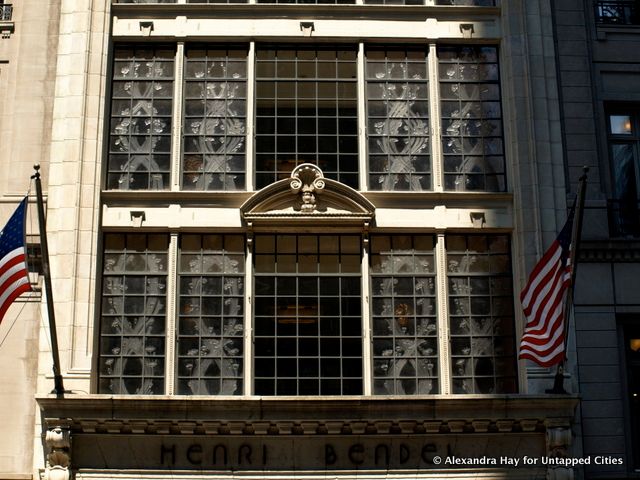
714 Fifth Avenue, the Lalique windows of the Henri Bendel Building
The Henri Bendel Building, formerly the Coty Building, is notable for the gorgeous windows on the second, third, and fourth floors, which are one of only two examples in the world of glassmaker and artist Rene Lalique’s pre-World War I architectural glass (the other can be found at Lalique’s townhouse in Paris). The windows were commissioned in 1912 by perfume magnate Francois Coty, and they depict flowering poppies and curving vines that call to mind the floral designs of Art Nouveau. In the mid-1980s, the Lalique windows played a central role in saving the building from demolition.
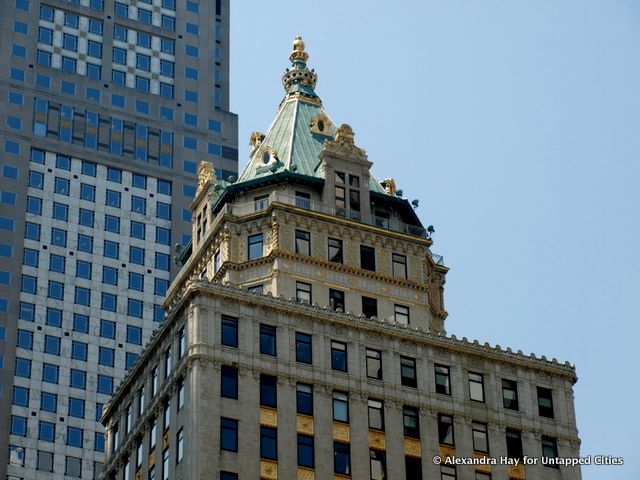
730 Fifth Avenue, the Crown Building
The Crown Building, like the Elizabeth Arden building above, was designed by Warren & Wetmore in the 1920s. Despite the fact that this was one of the first office buildings erected after the 1916 Zoning Resolution, its massing is not very different from that of older buildings. Instead of setbacks, it is topped with an octagonal “hat,” a copper roof, and plenty of gilded details, including a gold crown. Surprisingly, given the glassy, modernist look of its current home, the Museum of Modern Art was originally housed on the 12th floor of the Crown Building, back in 1929.
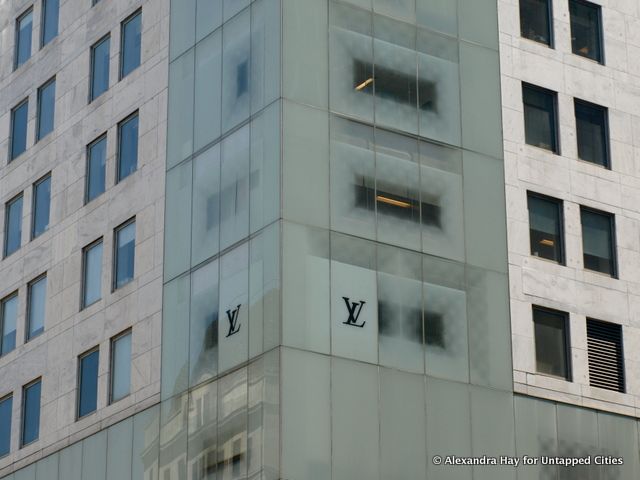
1 East 57th Street on the northeast corner of Fifth Avenue, Louis Vuitton
We conclude this section with a contemporary update of a 1930 Art Deco building. In 2004, Japanese architect Jun Aoki redesigned Cross & Cross’ New York Trust Company Building for Louis Vuitton, cladding the lower floors and the corner of the upper floors with glass.
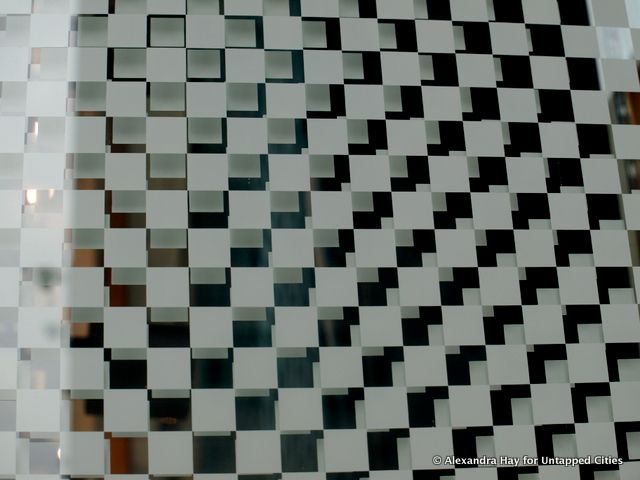
Louis Vuitton, detail of checkerboard glass
What appears to be an optical illusion from the street is created by layers of glass with overlapping checkerboard patterns. As you walk by, the patterns dizzyingly seem to shift and coalesce.
Next week, Don’t Forget to Look Up heads to the Upper East Side, covering Fifth Avenue along Central Park to 79th Street!
Subscribe to our newsletter